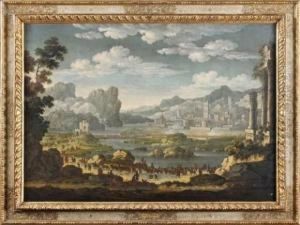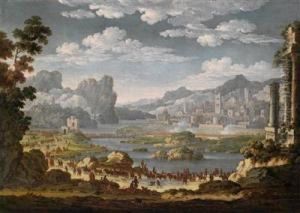Jan Van Bunnik Paintings
Jan van Bunnik was a Dutch painter born in the mid-17th century, specifically in 1654, in Utrecht, a city renowned for its rich artistic tradition during the Dutch Golden Age. His exact date of death is recorded as December 16, 1727, also in Utrecht. Van Bunnik was primarily known for his landscape paintings, which depicted both Italianate and native Dutch scenes, reflecting a common trend among Dutch artists of the period who were influenced by the idealized landscapes of Italy.
Van Bunnik's journey into the art world was significantly shaped by his environment and the prevailing artistic influences of his time. Utrecht, his birthplace, was a hub for artists who were keen on integrating Italian influences into Dutch art. This was partly due to the Grand Tour, a traditional trip across Europe, particularly Italy, undertaken by affluent young Europeans to acquire cultural, art, and architectural education. Although there is limited documentation on Van Bunnik’s training, it is known that he was a pupil of Herman Saftleven in Utrecht, a prominent landscape painter of the time. Saftleven's influence is evident in Van Bunnik's early works, which showcase a keen eye for detail and a profound appreciation for the pastoral landscape.
Throughout his career, Jan van Bunnik demonstrated versatility, delving into various thematic genres, including Italianate landscapes, which featured idyllic and often romanticized visions of the Italian countryside, and more traditional Dutch landscapes, which depicted the serene and meticulously detailed scenes of his homeland. His Italianate landscapes were particularly noted for their warm tones and the subtle play of light, characteristics that drew heavily from his Dutch artistic heritage while incorporating the romantic qualities associated with Italy.
Despite his talents and contributions to the Dutch painting tradition, Jan van Bunnik did not achieve the same level of fame as some of his contemporaries, such as Jacob van Ruisdael or Aelbert Cuyp. Nevertheless, his works are appreciated for their contribution to the landscape genre, offering insights into the cross-cultural artistic exchanges between the Dutch Republic and Italy during the 17th century. Van Bunnik's paintings are characterized by their detailed representation of naturalistic landscapes, a testament to the artist's skills and his ability to capture the essence of his subjects.
Jan van Bunnik's legacy, though not as widely recognized as that of some of his peers, remains significant in the study of Dutch Golden Age painting. His works are preserved in various museums and collections, where they continue to be studied and admired for their beauty and historical value. Van Bunnik's paintings not only reflect the artistic traditions and innovations of his time but also provide a window into the cultural and aesthetic exchanges that shaped European art in the 17th century.

